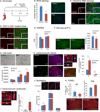The oxygen-rich postnatal environment induces cardiomyocyte cell-cycle arrest through DNA damage response
- PMID: 24766806
- PMCID: PMC4104514
- DOI: 10.1016/j.cell.2014.03.032
The oxygen-rich postnatal environment induces cardiomyocyte cell-cycle arrest through DNA damage response
Erratum in
- Cell. 2014 May 22;157(5):1243
Abstract
The mammalian heart has a remarkable regenerative capacity for a short period of time after birth, after which the majority of cardiomyocytes permanently exit cell cycle. We sought to determine the primary postnatal event that results in cardiomyocyte cell-cycle arrest. We hypothesized that transition to the oxygen-rich postnatal environment is the upstream signal that results in cell-cycle arrest of cardiomyocytes. Here, we show that reactive oxygen species (ROS), oxidative DNA damage, and DNA damage response (DDR) markers significantly increase in the heart during the first postnatal week. Intriguingly, postnatal hypoxemia, ROS scavenging, or inhibition of DDR all prolong the postnatal proliferative window of cardiomyocytes, whereas hyperoxemia and ROS generators shorten it. These findings uncover a protective mechanism that mediates cardiomyocyte cell-cycle arrest in exchange for utilization of oxygen-dependent aerobic metabolism. Reduction of mitochondrial-dependent oxidative stress should be an important component of cardiomyocyte proliferation-based therapeutic approaches.
Copyright © 2014 Elsevier Inc. All rights reserved.
Figures







Comment in
-
Cardiovascular biology: Switched at birth.Nature. 2014 May 29;509(7502):572-3. doi: 10.1038/509572a. Nature. 2014. PMID: 24870539 No abstract available.
-
Oxygen: double-edged sword in cardiac function and repair.Circ Res. 2014 Oct 24;115(10):824-5. doi: 10.1161/CIRCRESAHA.114.305322. Circ Res. 2014. PMID: 25342770 No abstract available.
References
-
- Ascuitto RJ, Ross-Ascuitto NT, Chen V, Downing SE. Ventricular function and fatty acid metabolism in neonatal piglet heart. Am J Physiol. 1989;256:H9–H15. - PubMed
-
- Becker RO, Chapin S, Sherry R. Regeneration of the ventricular myocardium in amphibians. Nature. 1974;248:145–147. - PubMed
-
- Bersell K, Arab S, Haring B, Kuhn B. Neuregulin1/ErbB4 signaling induces cardiomyocyte proliferation and repair of heart injury. Cell. 2009;138:257–270. - PubMed
Publication types
MeSH terms
Substances
Grants and funding
LinkOut - more resources
Full Text Sources
Other Literature Sources
Medical
Molecular Biology Databases

